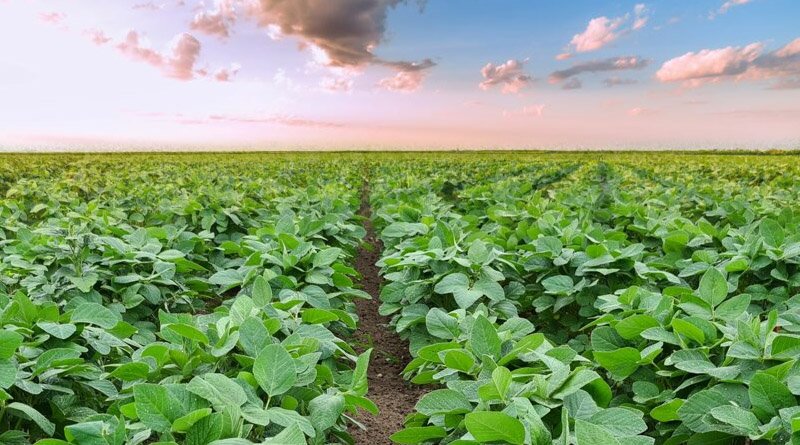Soybean is a leguminous, dicotyledonary, and important oilseed crop with 60–80 pods per plant. Many botanists believe that soybeans are domesticated in Central China.

Soybean is a leguminous, dicotyledonary, and important oilseed crop with 60–80 pods per plant. Many botanists believe that soybeans are domesticated in Central China. It is an indigenous crop in Pakistan and was first introduced in 1969.
Soybeans are made up of two types of
- Genetically modified organisms (those that undergo genetic change for a specific purpose)
- Non-genetically modified organisms (that do not undergo genetic change)
So here, I am going to discuss genetically modified soybeans. Genetically modified soybean means that DNA is introduced from any other species by using Genetic engineering techniques to solve specific problems due to biotic or abiotic factors.
Genetically modified soybeans are made for various purposes, e.g., Roundup-ready soybeans for glyphosate resistance, and HB4 soybeans are made to tolerate abiotic stress such as drought and hypersaline conditions. Soybean is genetically modified to improve its oil quality by increasing oleic acid and stearic acid and decreasing linolenic acid.
The modified soybean usually includes two methods: agrobacterium-mediated transformation from explant tissues and particle bombardment.
Agrobacterium-mediated transformation is simple and cheap, but it has the limitation that it produces single or low-copy insertions with a low chance of rearrangement. Particle bombardment involves the use of tungsten or gold particles to target plant cells for a specific gene.
Further approaches to the transformation of soybean include
Cotyledonary node base transformation:
The transgenic soybean plants have been successfully and reproducibly produced using mature or immature cotyledon explants via Agrobacterium-mediated transformation. Although this method is used, its transformation ability is very low.
Immature embryo based transformation:
This method depends on genotype and is limited to a few genotypes. The immature embryos excised from soybean pods suspended on semi-solid or liquid media containing high concentrations of auxin, 2,4-Dichlorophenoxyacetic acid (2,4-D), and the whole plantlets were recovered [24–25].
Immature embryos were developed as an alternative plant material. It has a high transformation ability and is a less chimeric plant. Its major limitation is that aged embryonic cultures lose fertility.
Embryonic shoot-based transformation:
This transformation of soybean involves the use of the meristematic cell, shoot, and apex by particle bombardment. The shoot derived from these meristems via organogenesis has been produced to form multiple shoots prior to mature plants. The explants have shown high regeneration and transformation efficiencies using Agrobacterium-mediated transformation, with up to 15.8%.
- Hypocotyl-based transformation: The hypocotyl is the embryonic stem located below the cotyledons in a germinating soybean seed. This transformation process includes the isolation of the hypocotyl, the preparation of the gene of interest, and the delivery of the gene into cells by agrobacterium-mediated transformation or particle bombardment.
- Leaf tissue-based transformation: Leaf tissue is used as the target for gene transfer and subsequent plant regeneration. This method is more suitable for mature plants or in cases where it is challenging to work with immature embryos or hypocotyls. Leaf tissue-based transformation provides a useful alternative for soybean transformation, especially when working with older plants or when other methods, such as hypocotyl-based transformation, may not be suitable.
87% of soybeans in the United States have been genetically modified. As soybean is crucial in poultry feed, its abundance is required.
The first GM variety of soybean (Roundup Ready) made by Monsanto in 1996 has resistance to the herbicide glyphosate. Genetic modified soybean is gaining popularity in market because of its advantages but it has disadvantages as well.
The modified soybean can grow for long periods of time, resulting in a reduction in price throughout the year. The GM soybean has resistance to harsh conditions like weed killers and harsh weather. This modification helps the plant survive different stresses, either biotic or abiotic.
Modified soybeans can grow better than non-genetically modified soybeans at low temperatures and in drought, resulting in an extended range of food production. The modified soybean is very useful in medicine and vaccines to treat human disease in a cost–effective manner.
The modified soybean can cause allergic reactions in some people. The effect of modified soybean tested on animals result that it damage the liver of animals. Some study reveals that use of GM soybean reduce the chance of breeding and reproducing.
Most soybeans are imported into Pakistan, and most of them are GMOs, which attract objections from various stakeholders. The Pakistan Biosafety Rules, 2005, require the mandatory registration of GMOs and Living Modified Organisms (LMOs) with the National Biosafety Council.
The registration process involves a detailed scrutiny of GMO or LMO-based products, including human health aspects. Therefore, the associated threats or benefits to the region will only be fully revealed once these products undergo a scientific review.